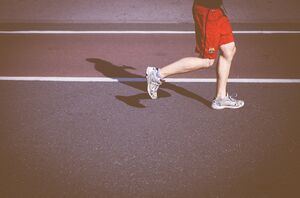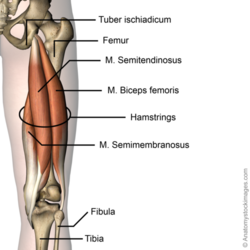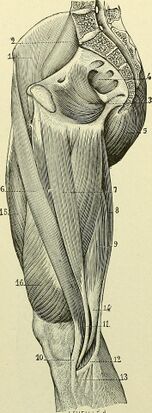Knee Flexors: Difference between revisions
No edit summary |
No edit summary |
||
| Line 5: | Line 5: | ||
</div> | </div> | ||
== Introduction == | == Introduction == | ||
The [[knee]] flexors include the set of [[hamstrings]], [[gracilis]], [[sartorius]], [[gastrocnemius]], [[plantaris]], and [[Popliteus Muscle|popliteus]]. Most of these knee flexors also internally or externally rotate the knee<ref name=":0">Mansfield PJ, Neumann DA. Essentials of kinesiology for the physical therapist assistant e-book. Elsevier Health Sciences; 2018 Oct 23. Available:https://www.sciencedirect.com/topics/neuroscience/knee-flexors (accessed 16.2.2022)</ref>. The hamstring muscles are the primary knee flexors. They play a key role in everyday movements, eg running | [[File:Knee flex.jpeg|thumb|Knee Flexion]] | ||
The [[knee]] flexors include the set of [[hamstrings]], [[gracilis]], [[sartorius]], [[gastrocnemius]], [[plantaris]], and [[Popliteus Muscle|popliteus]]. Most of these knee flexors also internally or externally rotate the knee<ref name=":0">Mansfield PJ, Neumann DA. Essentials of kinesiology for the physical therapist assistant e-book. Elsevier Health Sciences; 2018 Oct 23. Available:https://www.sciencedirect.com/topics/neuroscience/knee-flexors (accessed 16.2.2022)</ref>. The hamstring muscles are the primary knee flexors. They play a key role in everyday movements, eg [[Running Biomechanics|running]], [[Walking - Muscles Used|walking]]. | |||
Bending of the knee is known as flexion. The opposite movement is extension. Flexion and extension are controlled by opposing [[muscle]] groups. | Bending of the knee is known as flexion. The opposite movement is extension. Flexion and extension are controlled by opposing [[muscle]] groups. | ||
| Line 15: | Line 16: | ||
Spanning the posterior thigh, the hamstring muscles are the primary knee flexors. The hamstrings also perform hip extension, excepting the short head biceps femoris. | Spanning the posterior thigh, the hamstring muscles are the primary knee flexors. The hamstrings also perform hip extension, excepting the short head biceps femoris. | ||
As the three of the four hamstrings cross the [[hip]], as well as the knee, the position of the hip (and knee) can significantly affect the functional length of these muscles. As such, both the extensibility and the maximal force generated by the hamstrings are highly dependent on the position of the hip. | As the three of the four hamstrings cross the [[hip]], as well as the knee, the position of the hip (and knee) can significantly affect the functional length of these muscles. As such, both the extensibility and the maximal force generated by the hamstrings are highly dependent on the position of the [[Hip Anatomy|hip]]. | ||
== Gracilis and Sartorius == | == Gracilis and Sartorius == | ||
| Line 24: | Line 25: | ||
== Gastrocnemius and Plantaris == | == Gastrocnemius and Plantaris == | ||
The gastrocnemius produces a large plantar flexion torques across the [[Ankle and Foot|ankle]], and as muscle crosses the posterior aspect of the knee, it is also a knee flexor. The relatively small plantaris, which also crosses the posterior knee, so is a flexor of the knee.<ref name=":0" /> | The gastrocnemius produces a large plantar flexion torques across the [[Ankle and Foot|ankle]], and as the muscle crosses the posterior aspect of the knee, it is also a knee flexor. The relatively small [[plantaris]], which also crosses the posterior knee, so is a flexor of the knee.<ref name=":0" /> | ||
== Popliteus == | == Popliteus == | ||
Latest revision as of 05:49, 17 February 2022
Original Editor - Lucinda hampton
Top Contributors - Lucinda hampton
Introduction[edit | edit source]
The knee flexors include the set of hamstrings, gracilis, sartorius, gastrocnemius, plantaris, and popliteus. Most of these knee flexors also internally or externally rotate the knee[1]. The hamstring muscles are the primary knee flexors. They play a key role in everyday movements, eg running, walking.
Bending of the knee is known as flexion. The opposite movement is extension. Flexion and extension are controlled by opposing muscle groups.
Hamstrings[edit | edit source]
The semitendinosus, semimembranosus, and biceps femoris (long and short heads) make up the hamstring group.
Spanning the posterior thigh, the hamstring muscles are the primary knee flexors. The hamstrings also perform hip extension, excepting the short head biceps femoris.
As the three of the four hamstrings cross the hip, as well as the knee, the position of the hip (and knee) can significantly affect the functional length of these muscles. As such, both the extensibility and the maximal force generated by the hamstrings are highly dependent on the position of the hip.
Gracilis and Sartorius[edit | edit source]
The gracilis and sartorius flex and internally rotate the knee and play an important role in providing stability to the medial side of the knee. They also have roles at the hip. These muscles attach proximally at the hip.
Distally these muscles course posterior to the medial-lateral axis of rotation of the knee, and with semitendinosus form a collective insertion on the proximal-medial tibia, commonly known as the pes anserinus. These three muscles all perform three common functions at the knee: Flexion of the knee; Internal rotation of the knee; Dynamic support of the medial collateral ligament, providing medial stability to the knee
Gastrocnemius and Plantaris[edit | edit source]
The gastrocnemius produces a large plantar flexion torques across the ankle, and as the muscle crosses the posterior aspect of the knee, it is also a knee flexor. The relatively small plantaris, which also crosses the posterior knee, so is a flexor of the knee.[1]
Popliteus[edit | edit source]
The popliteus helps unlock the knee when the knee is in full extension. The hamstrings don't have much leverage from that position, and the small popliteus is crucial here. The popliteus externally rotates femur on tibia, the locked ligaments loosen, and hamstrings can then flex free[2]
See Also[edit | edit source]
Manual Muscle Testing: Knee Flexion
References[edit | edit source]
- ↑ 1.0 1.1 Mansfield PJ, Neumann DA. Essentials of kinesiology for the physical therapist assistant e-book. Elsevier Health Sciences; 2018 Oct 23. Available:https://www.sciencedirect.com/topics/neuroscience/knee-flexors (accessed 16.2.2022)
- ↑ Radiopedia Knee Available:https://radiopaedia.org/articles/knee-joint-1?lang=gb (accessed 16.2.2022)










